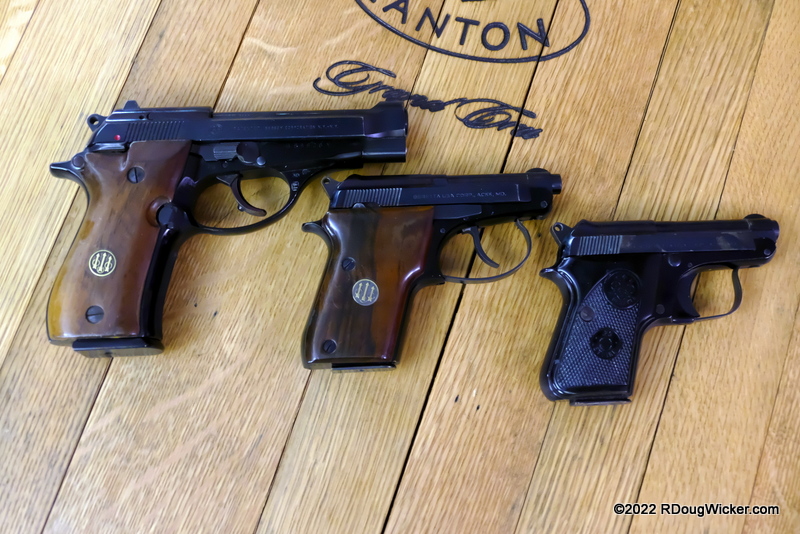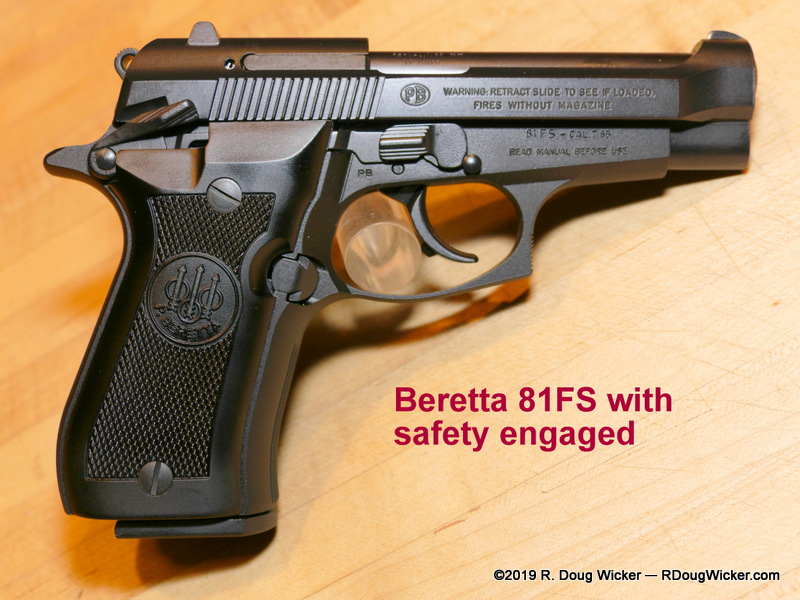Next week I start a new travel series, but in the meantime, this is Beretta Week. Can you guess from the image above what’s on tap today, Wednesday, and this week’s Fun Firearm Friday? Hint number one: Although it looks similar to the larger and much more famous Beretta 92, the firearm on the left is a smaller blowback pistol chambered in .380 ACP/9mm kurz. Give up? Well, then, the one on the left is a Beretta 84 Cheetah. Specifically, the firearm we’re perusing today is an 84B dating back to 1982.
I’ve clued you in on the remarkable Beretta 81-series pistols before, but with the current FS models. First was in November of 2016 with Shooting a Pair of Cheetahs — Comparing the Beretta 84FS and 85FS. I followed up in February 2019 with a bit of a rarity: Beretta 81FS Cheetah — And tips on gun collecting. Today we’re going back in time, back to when the Beretta 84B was produced. That would be during the short span from 1980 to 1984.
You’ll note that this example is in remarkable condition for a handgun celebrating its 38th birthday. Save for the left grip missing the “PB” — short for Pietro Beretta — medallion, there’s not much here about which to complain. The bluing is in good condition, the factory wood grips are relatively unmarred, and a replacement “PB” medallion has been ordered and should be here by the time you read this! And while you’ll note from the image below that this example came with a factory box, don’t get too excited. I wasn’t.
I mean, sure, it looks complete, but there’s a catch:
This box, while correct for the 84B and the year this example was born, is not the box originally issued to this specific firearm. How did I know this before I even decided to take it? Simple. The serial number on the label doesn’t match that on the firearm. Neither the clerk nor the store owner had noticed the discrepancy. This is something to watch out for when you think you’re getting a complete set on a collectible.
Nevertheless, that’s not that big a deal. It beats the later expense of having to purchase a correct era box and owner’s guide on eBay. Besides, this example was not priced out of line even for a firearm that was missing the extras. And it’s always great to have an original owner’s manual:
Now time for a little history lesson. The Beretta 81-series pistols began life in 1976, and would eventually include Cheetah models 81, 82, 83, 84, 85, 86, 87, 87 Target, and 89. If you’re wondering about those designations, here’s a breakdown:
- Model 81: .32 ACP/7.65mm with 12-round, double-stack magazine and wide grip
- Model 82: .32 ACP/7.65mm with 9-round, single-stack magazine and thin grip
- Model 83: .380 ACP/9mm kurz with 7-round, single-stack magazine, and longer 4-inch/102mm barrel
- Model 84: .380 ACP/9mm kurz with 13-round, double-stack magazine
- Model 85: .380 ACP/9mm kurz with 8-round, single-stack magazine
- Model 86: .380 ACP/9mm kurz with 8-round magazine; differs from other Cheetahs in that it has longer 4.37-inch/111mm barrel, and a unique tipping barrel that allows a round to be dropped directly into the chamber rather than necessitating a load from the magazine
- Model 87: .22 LR with 10-round magazine
- Model 87 Target: .22 LR with one of the longest barrels in the Cheetah line at 5.91 inches/150mm
- Model 89: .22 LR with 8-round magazine; this is the competition model of the Cheetah series; it has the longest barrel at 5.98 inches/152mm and weighs in at a rather hefty 41 ounces/1,160 grams.
- Browning BDA380: Now, this one is a bit tricky. The BDA380 was indeed based upon the Beretta 81 and 84, but examples were made not only by Beretta (.380 ACP/9mm kurz), but also Fabrique Nationale (FN) Herstal (.32 ACP/7.5mm) of Belgium. Visual differences include an enclosed barrel and a slide-mounted safety. Even the grips look nearly the same, down to the medallion inserts. The primary difference there is that the medallions show “B” for Browning rather than the three arrows on the right grip and the “PB” on the left.
As for those letters that follow the model number? Let’s stick to the Model 84 specifically on this. The original 1976 Model 84 had no letter following the number. In 1980 the improved 84B arrived, with a shortened extractor, groves added to the frame at the front and back straps, an automatic firing pin safety, and a trigger disconnect when the safety is engaged. The 84BB changes included improvements to the sights, which previously were all black combat-style. Additional cocking serrations were placed on the slide, and the slide was made wider and slightly heavier. There were also changes to the guide rod and recoil spring.
Things got more interesting with the change from the 84BB to the 84F and later FS. Engaging the safety on the original Model 84, 84B, and 84BB resulted in a 1911-style cocked-and-locked situation in which the hammer is cocked, leaving this Double-Action/Single-Action (DA/SA) pistol in single-action mode once the safety is disengaged. Internally the barrel and chamber gained chrome lining.
Cosmetically, the differences between the 84BB and 84F were huge. The finish went from high-gloss blue to Beretta’s more durable, semi-matte Bruniton finish (and, yes, I’ve seen a factory nickel version of the FS as well). Gone were the wood grips with medallions; they were replaced with hard plastic grips. The elegantly rounded trigger guard gave way to a squared-off combat-style with some front serrations. The slide was also notched at the safety, and the slide indentation for the catch was now hidden from view. You can see some of these changes in the image below from my previous 2016 article on the 84FS and 85FS Cheetahs:
As for the changes between the 84F and 84FS, you won’t see any, but there’s one internal difference. The safety on the 84FS supposedly has a more positive engagement. The criticism with the 84F was that you could halfway engage the safety, leaving one with the mistaken tactile impression that the safety was engaged. The hammer would remain cocked, and if you pulled the trigger, the gun would still fire. Now, I tried this on an 84FS and 85FS, and as far as I can tell it still operates that way. So, if you have either an F or FS, be warned — that safety must be fully and forcefully engaged to the point where the hammer drops before the gun is truly placed in a safe condition.
As with the previously reviewed Beretta 84FS, most of the specifications remain the same save for the weight. This is a result of the slightly narrower, lighter slide. My measurements show a difference of 40 grams/1.4 ounces.
Beretta 84B:
- Length: 6.77 inches/172mm
- Width (see text): 1.37 inches/35mm
- Width (at grip): 1.37 inches/35mm
- Height: 4.8 inches/122mm
- Weight (with empty magazine): 22.4 ounces/634 grams
- Barrel: 3.82 inches/97mm
- Capacity: 13+1
I hope you’re enjoying Beretta week. We’ve now finished with the firearm on the left (see below). On Wednesday we move on to something even smaller, that little guy in the middle:
Слава Україні! (Slava Ukraini!)











































 Decisions — Murder in Paradise
Decisions — Murder in Paradise The Globe — Murder in Luxury
The Globe — Murder in Luxury